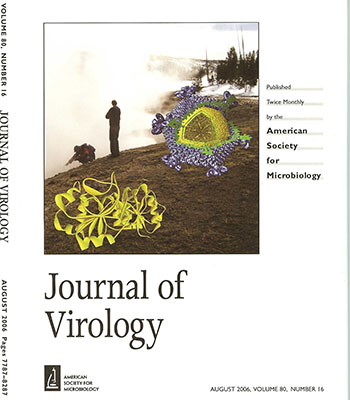Outreach Highlights
Form Determines Function and Reveals Evolutionary Roots in an Ancient Virus
The superheated and acidic waters of Yellowstone National Park are home to a dizzying
array of life, including members of the Archaea, as well as the viruses which infect
them. Sulfolobus turreted icosahedral virus, or STIV, is a virus which infects the Sulfolobus species that thrive in Yellowstone thermal features, and it was the first non-tailed
icosahedral virus to be characterized from an archaeal host. Because the study of
these unique viruses is still in its infancy, very little is known about STIV; though
clearly, much remains to be learned from these thermophilic viruses. Further study
of STIV is expected to provide genetic, biochemical, and evolutionary insight into
thermophilic viruses in general, their hosts, and the requirements for life in such
extreme environments.
The STIV virus encapsidates a circular, double-stranded DNA genome which encodes
for 35 viral proteins. TBI’s Young, Douglas, Dlakić, Copié, Bothner and Lawrence laboratories
are all collaborating on studies to better understand the virus, its hosts, and the
strange ecosystems that thrive in Yellowstone’s geysers and hot springs. The results
of two such studies, spearheaded by the Bothner and Lawrence laboratories, respectively,
were recently featured on the cover of the Journal of Virology. The results elucidated
in the Bothner et al article are summarized in Archaeal Virus Provides an Evolutionary Link to a Common Ancestor.
The work of the Lawrence laboratory is focused on structural studies of STIV proteins.
While proteins similar to those encoded by STIV are generally not found in the existing
databases, it is highly unlikely that most of the STIV genome codes for unique proteins
serving novel functions. Rather, similarities in protein sequence are probably unrecognizable
due to their distant relationships to homologs in other organisms. However, distant
similarities can often be unlocked through studies of protein structure. To this
end, Eric Larson, a graduate student with Dr. Lawrence, used X-ray crystallography
to determine the structure of one such protein, A197.
The crystal structure of the A197 protein, one of the first STIV proteins to lend
itself to this technique, reveals that it is a glycosyltransferase, a protein that
transfers sugars to other proteins. The realization that A197 is a glycosyltransferase
adds to growing evidence that the STIV virus may be part of a viral lineage that predates
the three domains of life. A glycosyltransferase protein is also found in related
eukaryotic and bacterial viruses. It is thought that A197 functions to add complex
sugars to the outer surface of the virus. An increased level of such sugars has been
correlated to environmental extremes in temperature, pH, and salt concentration. Thus
the A197 protein may help to stabilize the STIV viral capsid, allowing it to exist
in the boiling, acidic hot springs of Yellowstone National Park.

These findings were featured on the cover of the August 2006 edition of the Journal of Virology
